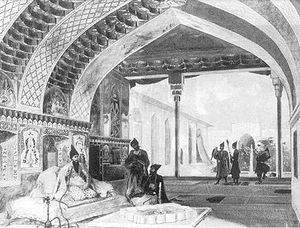
Erivan Khanate
Encyclopedia
The Khanate
of Erivan ( — Khānāt-e Īravān, also known as Čoḵūr Saʿd), was an administrative territory that was established Safavid Persia in the early 17th century. It covered an area of roughly 7,500 square miles, and corresponded to most of present-day central Armenia
, most of the Iğdır Province
of present-day Turkey
, and the Sharur
and Sadarak
rayons of the Nakhchivan Autonomous Republic of present-day Azerbaijan
.
As a result of the Persian defeat in the last Russo-Persian War
, it was ceded to the Russian Empire
in accordance with the 1828 Treaty of Turkmenchay
. Immediately following this, the territories of the former Khanate of Erivan and the Khanate of Nakhichevan were joined to form the "Armenian oblast
".
to preside over their domains, thus creating an administrative center. These khans from the Qajar tribe, which is of Turkic origin, also known as the sirdar (Pers. sardār, “chief”), governed the entire khanate, from the mid-17th century until the Russian occupation in 1828. The khanate was divided into fifteen administrative districts called maḥall
s. Persian rule was interrupted by Ottoman
occupations between 1513–14, 1533–34, 1548–49, 1553–55, 1580–1604, 1635–36 and 1722-36.
in the territory of the Khanate lived under the immediate jurisdiction of the melik
of Erevan, from the House of the Melik-Aghamalyan family, who had the sole right to govern them with the authorization of the shah. The inception of the melikdom of Erevan appears only after the end of the last Ottoman-Safavid war in 1639 and seems to have been a part of an overall administrative reorganization in Persian Armenia after a long period of wars and invasions. The first known member of the family is a certain Melik Gilan but the first certain holder of the title of "melik of Erevan" was Melik Aghamal and it may be from him that the house had taken its surname. One of his successors, Melik-Hakob-Jan, attended the coronation of Nāder Shah in the Mughan plain
in 1736.
Under the melik of Erevan were a number of other meliks in the khanate, with each maḥall inhabited by Armenians having its own local melik. The meliks of Erevan themselves, especially the last, Melik Sahak II, were among the most important, influential and respected individuals in the khanate and both Christians and Muslims alike sought their advice, protection and intercession. Second in importance only to the khan himself, they alone among the Armenians of Erevan were allowed to wear the dress of a Persian of rank. The melik of Erevan had full administrative, legislative and judicial authority over Armenians up to the sentence of the death penalty, which only the khan was allowed to impose. The melik exercised a military function as well, because he or his appointee commanded the Armenian infantry contingents in the khan’s army. All the other meliks and village headmen (tanuters) of the khanate were subordinate to the melik of Erevan and all the Armenian villages of the khanate were required to pay him an annual tax.

Khanate
Khanate, or Chanat, is a Turco-Mongol-originated word used to describe a political entity ruled by a Khan. In modern Turkish, the word used is kağanlık, and in modern Azeri of the republic of Azerbaijan, xanlıq. In Mongolian the word khanlig is used, as in "Khereidiin Khanlig" meaning the Khanate...
of Erivan ( — Khānāt-e Īravān, also known as Čoḵūr Saʿd), was an administrative territory that was established Safavid Persia in the early 17th century. It covered an area of roughly 7,500 square miles, and corresponded to most of present-day central Armenia
Armenia
Armenia , officially the Republic of Armenia , is a landlocked mountainous country in the Caucasus region of Eurasia...
, most of the Iğdır Province
Igdir Province
Iğdır Province is a province in eastern Turkey, located along the border with Armenia, Azerbaijan , and Iran. Its adjacent provinces are Kars to the northwest and Ağrı to the west and south...
of present-day Turkey
Turkey
Turkey , known officially as the Republic of Turkey , is a Eurasian country located in Western Asia and in East Thrace in Southeastern Europe...
, and the Sharur
Sharur
Sharur is an rayon of Azerbaijan in the Nakhchivan Autonomous Republic.-History:Sharur formed part of the territory of the Nakhichevan Khanate until its abolition in 1828. In the Russian empire it was made a part of the Armenian Oblast. After the oblast was abolished, it became a part of...
and Sadarak
Sadarak
Sadarak is a rayon of Azerbaijan in the Nakhchivan Autonomous Republic. It was split from the Ilyich rayon in 1990. It has an exclave in Armenia, Karki which has been under Armenian control since May 1992 when it was captured during the Nagorno-Karabakh War. Its capital is Sədərək....
rayons of the Nakhchivan Autonomous Republic of present-day Azerbaijan
Azerbaijan
Azerbaijan , officially the Republic of Azerbaijan is the largest country in the Caucasus region of Eurasia. Located at the crossroads of Western Asia and Eastern Europe, it is bounded by the Caspian Sea to the east, Russia to the north, Georgia to the northwest, Armenia to the west, and Iran to...
.
As a result of the Persian defeat in the last Russo-Persian War
Russo-Persian War, 1826-1828
The Russo-Persian War of 1826-1828 was the last major military conflict between the Russian Empire and the Persian Empire.After the Treaty of Gulistan concluded the previous Russo-Persian War in 1813, peace reigned in the Caucasus for thirteen years...
, it was ceded to the Russian Empire
Russian Empire
The Russian Empire was a state that existed from 1721 until the Russian Revolution of 1917. It was the successor to the Tsardom of Russia and the predecessor of the Soviet Union...
in accordance with the 1828 Treaty of Turkmenchay
Treaty of Turkmenchay
The Treaty of Turkmenchay was a treaty negotiated in Turkmenchay by which the Qajar Empire recognized Russian suzerainty over the Erivan khanate, the Nakhchivan khanate, and the remainder of the Talysh khanate, establishing the Aras River as the common boundary between the empires, after its...
. Immediately following this, the territories of the former Khanate of Erivan and the Khanate of Nakhichevan were joined to form the "Armenian oblast
Armenian Oblast
The Armenian Oblast or Armenian Province ) was an oblast of the Russian Empire that existed from 1828 to 1840. It roughly corresponded to most of present-day central Armenia, the Iğdır Province of present-day Turkey, and present-day Azerbaijan's Nakhchivan exclave...
".
Government
During Persian rule, the Shahs appointed the various khans as beglerbegīBeylerbey
Beylerbey is the Ottoman and Safavid title used for the highest rank in the hierarchy of provincial administrators It is in western terms a Governor-general, with authority...
to preside over their domains, thus creating an administrative center. These khans from the Qajar tribe, which is of Turkic origin, also known as the sirdar (Pers. sardār, “chief”), governed the entire khanate, from the mid-17th century until the Russian occupation in 1828. The khanate was divided into fifteen administrative districts called maḥall
Mahalle
Mahalle is an Arabic word, adopted into Turkish which is variously translated as district, quarter, ward, or "neighborhood." It is an official administrative unit in many Middle Eastern countries. In the Ottoman Empire the mahalle was the smallest administrative entity...
s. Persian rule was interrupted by Ottoman
Ottoman Empire
The Ottoman EmpireIt was usually referred to as the "Ottoman Empire", the "Turkish Empire", the "Ottoman Caliphate" or more commonly "Turkey" by its contemporaries...
occupations between 1513–14, 1533–34, 1548–49, 1553–55, 1580–1604, 1635–36 and 1722-36.
Population
At the time of the Russian annexation of the Erevan Khanate in 1828, Armenians formed about less than 20% (about 15,000) of the population, while the remaining 80% was made up of Muslims (Persian, Azeri, Kurdish), forming a total population of 102,000.Armenian autonomy
ArmeniansArmenians
Armenian people or Armenians are a nation and ethnic group native to the Armenian Highland.The largest concentration is in Armenia having a nearly-homogeneous population with 97.9% or 3,145,354 being ethnic Armenian....
in the territory of the Khanate lived under the immediate jurisdiction of the melik
Melik
Мelik , from malik ) was a hereditary Armenian noble title, in various Eastern Armenian principalities known as melikdoms encompassing modern Yerevan, Kars, Nakhchivan, Sevan, Lori, Artsakh, Tabriz and Syunik starting from the Late Middle Ages until the end of the nineteenth century...
of Erevan, from the House of the Melik-Aghamalyan family, who had the sole right to govern them with the authorization of the shah. The inception of the melikdom of Erevan appears only after the end of the last Ottoman-Safavid war in 1639 and seems to have been a part of an overall administrative reorganization in Persian Armenia after a long period of wars and invasions. The first known member of the family is a certain Melik Gilan but the first certain holder of the title of "melik of Erevan" was Melik Aghamal and it may be from him that the house had taken its surname. One of his successors, Melik-Hakob-Jan, attended the coronation of Nāder Shah in the Mughan plain
Mughan plain
Mugan plain is a plain in northwestern Iran and the southern part of the Republic of Azerbaijan. The highest density of irrigation canals is in the section of the Mugan plain which lies in the Republic of Azerbaijan. It is located on the bank of the Aras river extending to Iran...
in 1736.
Under the melik of Erevan were a number of other meliks in the khanate, with each maḥall inhabited by Armenians having its own local melik. The meliks of Erevan themselves, especially the last, Melik Sahak II, were among the most important, influential and respected individuals in the khanate and both Christians and Muslims alike sought their advice, protection and intercession. Second in importance only to the khan himself, they alone among the Armenians of Erevan were allowed to wear the dress of a Persian of rank. The melik of Erevan had full administrative, legislative and judicial authority over Armenians up to the sentence of the death penalty, which only the khan was allowed to impose. The melik exercised a military function as well, because he or his appointee commanded the Armenian infantry contingents in the khan’s army. All the other meliks and village headmen (tanuters) of the khanate were subordinate to the melik of Erevan and all the Armenian villages of the khanate were required to pay him an annual tax.
List of Khans

- 1736-40 Tahmasp-qulu khan
- 1740-47 Nader Shah
- 1745-48 Mekhti-khan Qasımlı
- 1748-50 Hasan Ali-khan
- 1750-80 Huseyn Ali Khan
- 1752-55 Khalil Khan
- 1755-62 Hasan Ali Khan Qajar
- 1762-83 Huseyn Ali Khan
- 1783-84 Qulam Ali (son of Hasan Ali)
- 1784-1804 Muhammed Khan
- 1804-06 Mekhti-Qulu Khan
- 1806-07 Muhammed Khan Maragai
- 1807-28 Huseyn Qulu Khan QajarHossein Khan SardarHosein Qoli Khan Sardar Qajar , the last Iranian governor of Azerbaijan, ruled as virtual shah of the Khanate of Erevan. In 1826-1828 he and Abbas Mirza, the Crown Prince, attempted to win back the Transcaucasian possessions lost to Russia during the war of 1804-1813 which had ended with the...

